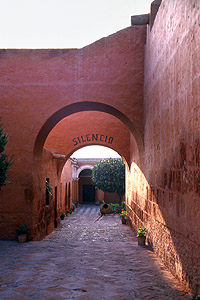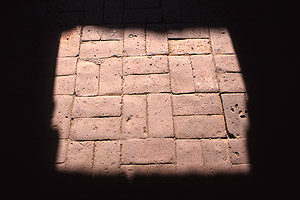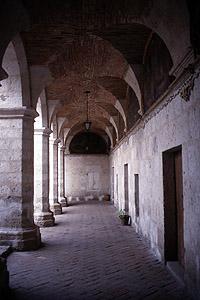Monday, 22 March 1999
Puno, Peru
We again had to get up early and we went straight away to the nearby Plaza Sucre to find a minibus to the border. When we got there we found very little action however we were shepherded into a taxi and sat in it waiting for more passengers. Fortunately the American couple we had met on the boat back from Isla del Sol turned up about ten minutes after us and we were able to get going. On the way we managed to get a bit of their interesting story. They had been on their way down the Panamerican highway in their VW combi and managed to arrive in Honduras about the same time as hurricane Mitch. It was total chaos and they were a bit terrified but fortunately someone offered to show them to a luxury hotel on dry ground. That night they heard the damage as it happened, buildings disappearing, electricity pylons sheering apart. They even experienced the water supply being cut off as a part of the mains crossing a bridge was washed away whilst one of them was showering. The next day they found out there were no roads, no petrol stations nothing so they had no option but to leave their combi in the safety of the hotel car park and continue their journey by plane. The Honduras they left behind, they said, was one of chaos where so many people had been left with literally nothing.
The border was more of a farce than usual. We got though Bolivian and Peruvian border control and hopped in a waiting minibus. They quoted some ridiculous price to take us two kilometres to the first Peruvian town and we said no. They cut their price but said we would have to wait for more passengers. The passengers eventually came but not from customs but from around the back of the customs block. Three campesinos carrying huge bundles on their backs crept around the back and into the minibus trying their hardest not to attract any attention. When they put their bundles down they clinked and it was obvious that they were smuggling alcohol into Peru. When we eventually got to the next town it was clear that they were not the only smugglers... the town was rife with them.
Our idea had been to get up very early in the morning to get to Puno as quickly as possible and then see if there was a midday bus to Cusco. When we got there we realised that there was no such bus and that it would be a night bus or a night in Puno. We opted for the second as it marginally seemed the least dangerous. We then attempted to kill the rest of the day in a cafe and thus avoid the continuous rain which were quickly turning Puno's muddy streets even muddier. A little light relief presented itself in the form of a pizza joint which actually did a respectable mulled wine.
Tuesday, 23 March 1999
Cusco, Peru
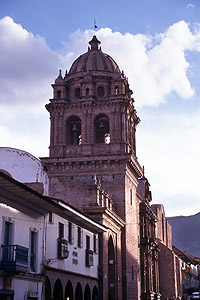
(Cusco, Peru)
The bus to Cusco was eventful to say the least. The Peruvian method of combating smugglers it seemed was to set up road blocks on the two roads going out of Puno. So nearly two thirds of the way through the journey, after having crossed through some almost breathtaking high Andean scenery, we were stopped and the bus searched. The woman sitting on the other side of the aisle from us was singled out and her baggage searched. It turned out that she was smuggling Alpaca jackets and she was fined. This all took about half an hour and about two minutes down the road we stopped for lunch for another half an hour. This annoyed us since we had already stopped for breakfast for an hour in Juiliaca and we were not very far from Cusco. Anyway eventually it was time to go and, as there was limited parking time, the bus pulled out of the station. However the smuggler was not on it despite the fact that her goods were still sitting in a bag on her seat. After about five minutes it was put to the vote and the vote was "Vamos" and so, quite amazingly, the bus left along with the jackets. We never saw her again.
Cusco was perhaps not quite what I had expected. I thought it would be small, compact and hemmed in by mountains. It was large and sprawling and although several suburbs did wind their way up slopes it was by no means hemmed in. We caught a taxi across town and quickly found a quite cheap, nice and virtually empty hotel. We then went out to explore. The main Plaza was huge, beautifully laid out and surrounded by some very impressive buildings. The Cathedral of Santo Domingo was built on Inca foundations, like a lot of Cusco's buildings, and looking at the perfect way the irregular blocks fitted together we got our first glimpses of the past. We then went to change some travellers cheques and walking back from the bank we bumped into Hans and Ester, a couple we had originally met in Bolivia.
We had dinner with them that night. It seemed that after pasting company in La Paz they had spent a couple of nights there, got rained on in the Isla del Sol and had spent a day in Puno visiting some of the islands in the Peruvian half of the lake. They had then got the train to Cusco and had arrived the day before us. We chatted for a while and talked a bit about the Inca Trail which they were to do the day after.
Wednesday, 24 March 1999
Cusco, Peru
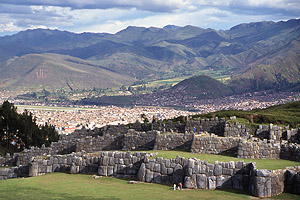
(Cusco, Peru)
Our plan had us staying two days in Cusco, one for sight-seeing the other for present shopping. This was to be our sights day after which we would go on the Inca Trail for four days and then we would do the shopping. However we still had to spend the morning shopping for a few things including some jeans since Anna's had effectively kicked the bucket. Our plan sadly lasted for half a day since that morning we went to a music school on the off chance that they gave zampoña lessons and as a result tracked down a guy who had a workshop on Saturday (27th). After much argument it was decided that we would stay in Cusco until then and start the trail on Sunday. It meant spending two extra days in Cusco but it was Anna's only chance of finding out about more than just the basics of Andean music.
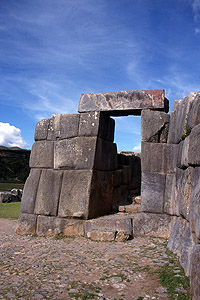
(Cusco, Peru)
Happily the delay would solve another problem. I had the first signs of a monster cold the day before and by lunch I was feeling so ill I had to go back to the hotel to sleep. Therefore it was obvious that music workshop or no music workshop we were not going on the Inca trail for a few days at least. After my nap we finally got down to some sight-seeing. Sacsayhuaman is a huge Inca defensive wall built to protect what was considered Cusco's weak point. It is in fact several parallel walls built in a zigzag, the theory being that they expose the flanks of any attackers. Inca Cusco was laid out in the form of a Puma with Sacsayhuaman being its teeth. All of these grand designs did little to stop the Spanish who overran the fort and demolished most of its buildings apart from the wall itself.
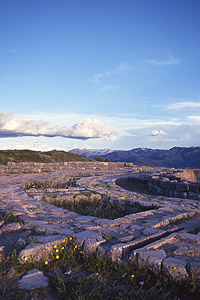
(Cusco, Peru)
The walk up was steep. We cut through several alleyways and emerged by the side of the impressive looking San Cristobal. We then carried on up the road and presented our "tickets" at the gate. Our tickets were very amusing. All of the sites in Cusco and the Sacred Valley are covered by a ten dollar "tourist ticket" which was a huge piece of paper with small pictures of each site around the edge. Every time you went to a site the picture would be clipped. Although ten dollars is a lot it was still worth it for us as we planned to go to the Inca ruins of Pisac and Ollantaytambo both of which cost nearly five dollars on their own. The walls were not at all obvious on our approach but it soon became clear why, rather than being walls in the European castle sense they resembled a set of zigzagging terraces. Whether this was as a result of age or design was not clear. In a few places the walls did rise above the terrace and you found yourself walking in a zigzag corridor. The build of the walls was the most impressive aspect. They were made of giant blocks of andesite so carefully shaped that I doubt you could even get a needle into most of the mortar less joins. The first wall was the most impressive. Standing on the field below them, much as an attacker would, it rose up at least three metres and most of the corner stones were the full height of the wall the biggest reportedly weighing 300 tonnes. In places the wall was penetrated by gates but on the other side of each gate was a staircase so steep that trying to get up it would be suicidal. All in all it was a pretty impressive piece of engineering.
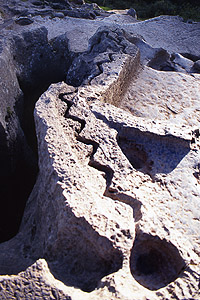
(Cusco, Peru)
We walked around for quite a while exploring the foundations of the structures in the inner fortress that were looted for building materials by the Spanish. We walked up the hill opposite it and had a look at the whole thing from above. One thing that puzzled me was that it seemed hardly positioned in the best place to defend Cusco. It could easily be outflanked on one side and cut off. In fact it seemed more likely that it was positioned for the sake of the Puma design than for defensive reasons.
After Sacsayhuaman we walked a couple more kilometres to Qenko a rock outcrop above Cusco that was used in various ceremonies. Here one of the more interesting carvings on the rock was a Y-shaped zigzag channel. Apparently the Inca priests would pour blood into the top of the channel and see which branch it followed in order to make key decisions. Once we had crawled all over the rock and even through it we returned to Sacsayhuaman for sunset. I attempted to get a picture of the base of a circular tower but a guide was taking a couple of tourists through some incantation using the circle of stones as some sort of magical arena. We were to see a lot of this sort of "mystical" behaviour by guides and I worried that in the end we would pay for a similar performance.
Thursday, 25 March 1999
Cusco, Peru
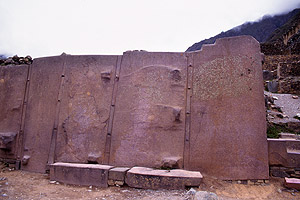
(Ollantaytambo, Cusco, Peru)
Vilcamayo or the Sacred Valley was our next destination. Although we would be visiting the valley on the Inca Trail there are two other important sites further up the valley towards Cusco. We started with the furthest away Ollantaytambo . Although we had followed the top of the Sacred Valley to get to Cusco and we would later on follow exactly the same route to get to the head of the Inca Trail I will never forget our first approach to the valley. You go up quickly from Cusco and then cross a high plateau and finally emerge above an area of patchwork fields which drop away into the valley. The opposite wall of the valley was black and so wreathed in clouds that you could not work out how tall the mountains on the other side were. We then descended via numerous switchbacks to the largish town of Urabamba and then went down the valley to get to Ollantaytambo.
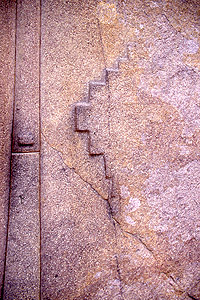
(Ollantaytambo, Cusco, Peru)
The village itself was very pleasant and had we time we would have probably stayed the night there. However the main star of the show was the fort. At the back of the villages Inca terraces rose all the way up the sheer sides of a mountain to a fort positioned on its slopes. Apparently the Inca's withdrew to Ollantaytambo after the siege of Cusco and the first Spanish attack on the fort resulted in their defeat. We climbed up the steep terraces and entered through a gate in the very finely crafted walls. One of the most impressive aspects of the fort was its site. Perched high up on a steep spur of a mountain you could see up and down the valley for quite a long way. Approach to the fort was only possible via the staircase up the terraces that the Inca's themselves had constructed and going up this you had the main defensive wall of the fort right beside you. Whereas Sacsayhuaman had looked impressive but had dubious defensive credentials, Ollantaytambo looked as if it could have resisted attack for years.
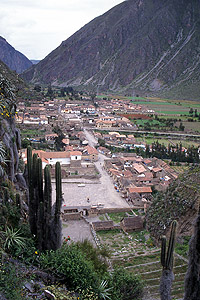
(Ollantaytambo, Cusco, Peru)
The other unusual aspect of Ollantaytambo (although we were not to realise this until we had seen all the other sites) was its Temple of the Sun. Whereas most of the major building work in the Sacred Valley had been commissioned in the time of the ninth Inca Pachacuti in the fifteenth century the Temple of the Sun was still not complete by the time of the fall of the Inca empire in the sixteenth century. Its design was, as far as we saw, unique. Made of pink granite the blocks were huge and of a very regular shape. More unusually they were carved on their outer faces, we could make out the three stepped diamond shape that apparently represents the Inca's view of the universe. With blocks of it still lying around waiting to be put into place it was a very impressive building and really was the sort of thing you could imagine being hacked out of the jungle by some intrepid Victorian explorer (well, except for the fact that there is no jungle this far up the Sacred Valley).
Ollantaytambo had more to offer than just the fort. At the bottom of the spur and a little way up the side valley it forms there is a set of baths. A tributary of the Urabamba feeds a set of stone channels that run some way downhill before emerging as four jets of water into two separate bathing areas. The quality of the stonework was amazing and although we did not go to the more impressive baths of Tambo Machay the Inca's reverence for water was clear.
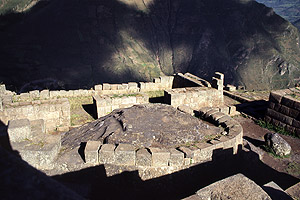
(Pisac, Cusco, Peru)
When we got back into town we jumped on a bus then changed buses in Urabamba and within about an hour got to Pisac . The level of commercialism in Pisac is on a par with Cusco. There is an artesania market that mysteriously takes place every other day and is positioned in the main square which is conveniently between the place where the buses drop you and the road up to the ruins. We had fortunately worked out that the tour buses go to Pisac in the morning and then to Ollantaytambo thus we counted few other tourists from where we sat in the market eating papas rellenas. The climb up to the ruins was a killer. A small track lead to the base of some terraces and then another track took us round the side of a waterfall and up to a series of fortified towers. Standing in the ruins of one of these towers I was able to get a picture of one of a pair of condors that circled briefly below before gaining some altitude and soaring into the distance. After the third tower we once again found ourselves at the base of terraces and were forced to take a painfully steep Inca staircase that went straight uphill to one side. It almost killed us and a couple that we overtook turned back before the top. Finally we rounded a small peak and gazed upon the Pisac's Temple of the Sun.
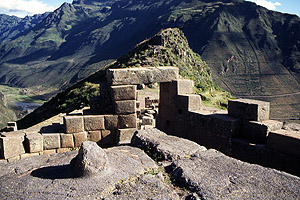
(Pisac, Cusco, Peru)
The temple was again constructed in smooth pink granite but there all similarities ended. The blocks were a lot smaller and there were a large number of interconnected buildings all over the site. We entered through a near perfect trapezoidal two-jamb doorway and walked around. We could have done with more information about the structures but it was easy to make out the solar observatory, where the windows were aligned with the sun rise at key points throughout the year, and the astronomical observatory which was skilfully built around a stone outcrop on top of which was the stump of a "hitching post" which was used to track the constellations. Again the setting was spectacular, either side of the temple the mountain fell away steeply and you could see for a long way in both directions. The rocky outcrop we had rounded earlier effectively concealed the temple from the point of view of the valley floor. Below us to one side of the temple was the settlement of Pisac itself, dramatically laid out in a semi-circle which exactly followed the line of the terraces which in turn were contoured with the hill. You had the feeling that whatever the Inca's had or had not achieved they were at least in tune with nature.
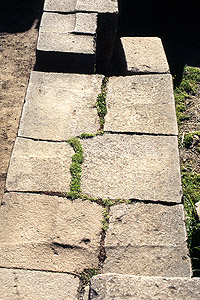
(Pisac, Cusco, Peru)
I had a bit of a problem taking the photographs that I wanted. The sun seemed to be permanently hiding behind a cloud and I had to sit and wait for it to come out. When it finally did it did not look like it would last so I had to run around the site like a madman taking photographs until my couple of minutes were up. We stayed for quite a while but since we needed to be back in Cusco for six thirty we finally had to leave. We took a slightly different route back which enabled us to have a quick look at the settlement. Back in Pisac town we briefly indulged the tourist market by making a bracelet for Anna from ceramic beads. The trip back was very peaceful. We cruised slowly over the high plateau between Pisac and Cusco in the light of the setting sun.
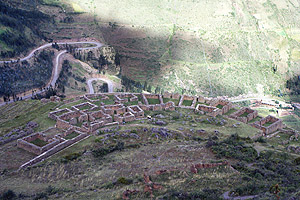
(Pisac, Cusco, Peru)
Back in Cusco we had to run so that Anna would make it to the music museum. Prof. Kike Pinto was going to give a demonstration of all the instruments in his collection and Anna had arranged to go along. I had declined in favour of having a quick wash and a look around town. When I finally joined Anna at seven thirty she and everyone else were standing in the alleyway outside the museum and there was a lot of shouting. It turned out that one of the traders in the alleyway had not paid her share of the communal electricity bill and so the rest of them had turned the lights off. This resulted in a bit of a struggle, the police were called etc. In the excitement the people from the music museum had locked themselves out. A rather unhappy looking guest musician stood by with a huge harp type thing. By the time it finally was all sorted out the poor guy was forced to leave to do his stint at a local restaurant. We all went inside and I soon realised that "we" consisted of Kike, Anna and I. Since I was fifty percent of the audience I decided to stick around and we listened to all the instruments. Afterwards he talked about different styles and plied us a few CDs. It appeared that most of the Andean music we listen to in the west is an amalgam of different styles that has only existed for the last ten years or so. After the lecture was over we went for dinner and then prepared ourselves for the next days shopping trip.
Friday, 26 March 1999
Cusco, Peru
We spent the whole day shopping. The big find of the day was a market stall where this old woman sold Quechua cast-offs at very reasonable rates. When we got there an American anthropologist was buying half the stall for presents for students. She had a huge sack into which prayer rugs, tapestry belts, etc. were stuffed. We bought a small bag, a piece of cloth which looked nice but we did not know what we would do with it and a small hat for the baby of a friend of ours. We were going to but another at for a friend of ours and the woman demonstrated tem all pulling strange faces but we still did not buy. The story with the hats was the most irritating. Everyone sold new knitted hats and very intricately embroidered old hats. The problem with these second-hand hats was that they really were second-hand and were often quite grubby. It took us hours but eventually we found one that was not so grubby and was not excessively decorated and large enough to fit any normally sized European head (most were too small). I became a bit suspicious about the whole thing - why were so many of these deeply personal hats for sale. The only explanation I could come up with was that someone had gone out to the villages with a container full of fake Nike baseball caps and overnight converted all the Quechua men to western fashion at the same time collecting up their traditional head gear. This may be a bit cynical but it is not too far off the truth. I felt a bit guilty about buying one just for a joke present but the damage had been done long ago.
That night we had to run around a bit. Anna wanted to attend a group Zampona workshop on Saturday which meant that we would be starting the Inca trail on Sunday. We had put our names down at the chosen agency but they had told us that unless more people appeared they would not be going that day. They told us that lots of people went to Pisac market on Sunday, etc. We went to another agency to check the story. No they would not go on Sunday because "it is the holy day and all the guides would go to Church". What about the groups that start on Saturday? "Oh well yes, that's okay but they just don't want to start anything new." Whatever the real reason behind it, it was clear that we were not going on the trail on Sunday. This caused problems because if we left it until Monday we would have little time left for other things. In the end we decided that we would have to miss the workshop, anyway Anna was having a private lesson that night and would have to learn the theory of playing in a group then.
My parents present caused nearly as many problems as the hat. I wanted to buy them some ceramics and as we had got closer to the Peruvian border we started to see lots of beautiful ceramics in the restaurants etc. and had worked out that these came from Cusco. The problem was that when we got to Cusco they were everywhere, every shop sold them, every guy on a street corner had them, every restaurant used them on their tables. After three days in Cusco I was starting to think they were not as unique as I had previously thought. Worse than this it seemed to be hard to find anything of any quality. In the end I walked into what looked like the most expensive ceramic shop in Cusco. I got a bit of a surprise, not only did they not sell Cusco ceramics (it was all from the North), what they did sell had a very reasonable price. I instantly leapt on a black ceramic bowl and vase and liked it all so much that we bought something for us as well.
Saturday, 27 March 1999
Huayllabamba, Cusco, Peru
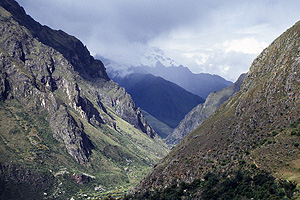
(Inca Trail, Cusco, Peru)
Day one of the Inca Trail. We had to get up relatively early and go to the trekking company's offices for breakfast. Then, half asleep, we were bundled in a minibus and driven to the sacred valley. Just before we left we found out that we could save five dollars by using our own tent, so this is what we did. This time there were less clouds and on the plateau above Urabamba we could see that as well as the patchwork of fields we were surrounded by snow capped mountains. After Urabamba we turned the wrong way up the valley and stopped outside a very nice looking country hotel. It turned out we were waiting for some more people and when they finally came it turned out that they were Dilys and Nancy, the two elderly Californian women who we had met on the boat coming back from the temple of the sun. We finally got underway again and drove down the valley towards Ollantaytambo. After the village we kept on driving alongside the railway tracks. The road was completely washed out a one point and here we had to transfer to camion for the rest of the journey. When we finally stopped driving it must have been nearly eleven. We were very happy to get walking and set off along the track at quite a speed.
The first part of the walk was through countryside not unlike the Lake District. We chatted amongst ourselves and slowly got into the rhythm of walking. We stopped for a cooked lunch at the side of quite a sheer gorge, at the opposite side a cliff rose us and was topped by a grassy plateau. The food was okay but it was clear that our taste buds would not be tingling at any point during the trip. We lazed around in the sun and were not that keen to get going again when it was time. After the plateau we came upon our first Inca settlement. Our guide started his stories of the Incas and how Machu Picchu was never discovered by the Spanish. It appeared that the route we would take there was by no means the shortest. We would be following a road that went through a string of smaller forts and settlements that were positioned on the route to one of the tallest snow capped mountains of the region that was sacred to the Incas. The shortest route was the one straight along the river but this is by no means as spectacular as the Inca Trail we were going to follow.
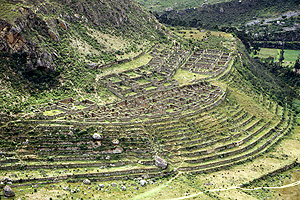
(Inca Trail, Cusco, Peru)
The first settlement we visited was Llactapata . Unlike previous ruins we had seen it was positioned only a couple of terraces up from the valley floor but it was arranged in a semi-circle. After this we carried on walking for a couple of hours to the village of Huayllabamba where we were to spend the night in what looked like a farmyard. The tents were already put up and after dumping our stuff we all sat down for a cup of tea. After dinner we all chatted for a while. There were so many people in the group that it would be a bit of an exercise to list them all. However we spent most of the four days chatting to Jonathon, an English guy also working in banking; Coone, a Dutch guy studying soil science and doing some research in Ecuador; Marga, a Dutch student who was working in a Cusco travel agent as part of a course in Tourism; Dheg, a Norwegian guy who was also travelling around the world; and Jonas, a German studying business administration who was eccentric enough to go around the trail with an umbrella. There were also two Norwegian girls, two British girls, a Danish guy in his fifties, two Australian lads, an Italian couple and an Israeli girl whose name we forgot to ask. It was probably too many people but on the other hand there was always someone to talk to.
Sunday, 28 March 1999
Runquracay, Cusco, Peru
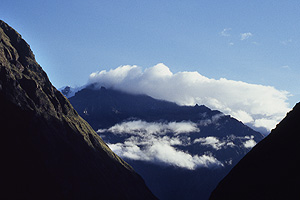
(Inca Trail, Cusco, Peru)
The second day of the Inca trail is supposedly the hardest. We were woken up at about ten past five with a cup of mate. It was supposed to be half past but we found out later that there was some problem with the cook's watch. Having taken our own tent we decided not to leave the job of packing it up to the porters so kept ourselves warm doing this. After breakfast we started off up the path towards Warmiwañusca or "Dead Woman's Pass" so called because of a rock formation at the top. The object of the day was this and only this. It took us only about three and a half hours but it was very tough going at the end. The last fifty or so steps I did almost one at a time. When we got to the top (4200m) we rested or a few minutes, by which time we had surprisingly got our breath back, and then descended about an hour on the other side.
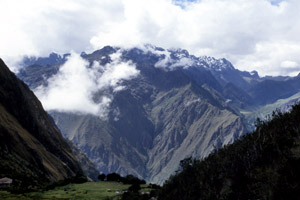
(Inca Trail, Cusco, Peru)
We got to the second camp site just below the pass at Runquracay a little before twelve. Dheg had found that a stream that cascaded down from a ridge above the pass formed a secluded pool near the camp. Everyone was practically queuing up to use it and it was a while before the two of us could take our turn. To say it was freezing would be the understatement of the year! Everyone ate their lunch ravenously and after this we had the whole of the afternoon free. On reflection I was slightly cross with the fact that we wasted the whole of the second afternoon. However our tour was for four days and we did it without having to rush at all. If I was doing it again on my own I think it would plan on three days - after all the record time for a local is two and a half hours!
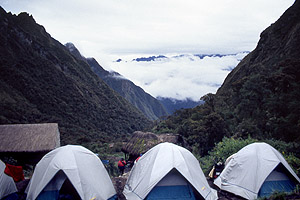
(Inca Trail, Cusco, Peru)
One point of interest was what happened to Dilys. I am not sure that the first pass is something I would be able to do the day before my sixtieth birthday but Dilys made a valiant attempt. Sadly the attempt ended with her having to be carried up on horseback. Nancy, only a few months younger, made it totally unaided.
We spent the afternoon writing diaries and watching the clouds shift around in the valley below. Eventually we had dinner and after dinner we played a few drinking games which suffered slightly from a lack of anything to drink. After this our guide told us our usual bedtime story about the history of the Inca's and we carried on chatting well in to the night.
Monday, 29 March 1999
Wiñay Wayna, Cusco, Peru
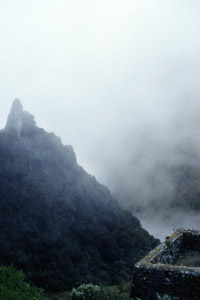
(Inca Trail, Cusco, Peru)
The third day of the Inca Trail would normally be the one with all the ruins. We were woken up at quarter to six, maybe to make up for the day before. It looked cloudy and as we walked up hill towards the second pass it looked like we would be in for rain. Just below the second pass Runquracay (3860m) was a small fort or tambo used to refuel on the way up into the mountains. Our guide showed us around it briefly and just as we set off the long expected rain started. Over the pass and a bout an hour further on we came to Sayacmarca, an Inca settlement and fort from where roads lead to the snow capped Salcantay, Machu Picchu and back to Cusco. Our guide walked us around and showed us the terraces, the temple, the aqueduct which brought water in from kilometres away etc. I think that the view would have been fantastic but the weather meant that we could only see a few metres downhill.
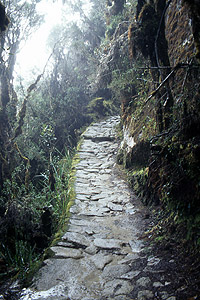
(Inca Trail, Cusco, Peru)
After this the rain got steadily worse and worse. I was more than a little upset about it because we were walking through cloud forest and from what little we could see when we peered out from under our hoods we could tell that it was amazing. Gnarled tress and lianas surrounded us, orchids grew everywhere and had it been sunny hummingbirds would have been darting in and out. Even the path was spectacular. Original Inca Road it was made out of white granite and hugged the contours of the mountainside so much so that it even had to tunnel though solid rock at one point. If we had been forced to cut our own path it would have been a nightmare but as it was we sprinted through the mountains. From what Hans and Ester later told us the view was stunning but again the weather never allowed us to see it.
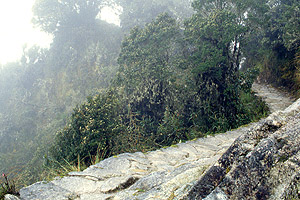
(Inca Trail, Cusco, Peru)
The third pass was hardly noticeable and just after it we got to the ruins of Puyupatamarca. The ruins here looked pretty extensive and in pretty good shape but our guide waved us on as the rain was just too hard to allow any kind of tour even if we had not been spread out along the trail over an hour between the first and the last. We carried on going down then got onto a very winy gravel track in very bad condition and finally reached the shelter of the visitor centre at the ruins if Wiñay Wayna. Here there was lots of panicking and several people checked themselves into the attached hostel thinking that the rain would make camping a bad option.
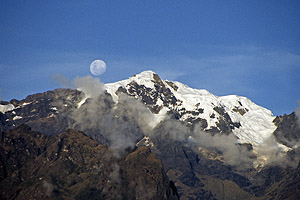
(Inca Trail, Cusco, Peru)
Perversely the rain stopped almost the moment we sat down. We purchased some beers and let our clothes dry in the sun. It was so warm that they gave off steam. As the clouds also evaporated away the view just got better and better. We were perched high above the Urabamba, still in cloud forest and the ridges and peaks of the opposite side of the valley were dark green and razor sharp. As the afternoon wore on distant snow-capped peaks became visible and I even managed to get a photograph of the moon rising out of one of them. We had lunch and sat around, pretty much in silence, as we absorbed the sun's rays, hoping they would reach our very bones which had got soaked during the day long shower.
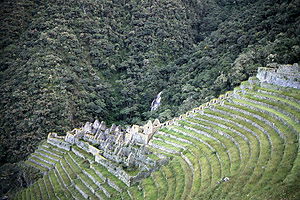
(Inca Trail, Cusco, Peru)
Around four we went to the ruins of Wiñay Wayna . I wish it had been earlier because by then thee was no sun and the ruins were spectacular. Again contoured to a set of terraces that went down for hundreds of metres the ruins consisted of a set of houses, a temple of the sun and a cascade of ceremonial baths. We spent a lot of time in the temple of the Sun whilst our guide revealed a lot of details about Inca life which, had the weather been better I am sure would have been relayed during the course of the day.
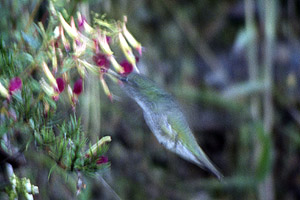
(Inca Trail, Cusco, Peru)
After our tour we went back, relaxed a bit more, had some tea etc. We finally managed to spot some hummingbirds as they drank nectar from the flowers behind our tents. Hopefully my camera was quick enough to get a picture of one. Then it was dinner which was naturally followed by a lot of talk. The availability of beer, at a cost, added a whole new dimension to our drinking games that night. Despite the fact that we were due to get up at four the next morning we kept drinking until midnight!
Tuesday, 30 March 1999
Cusco, Peru
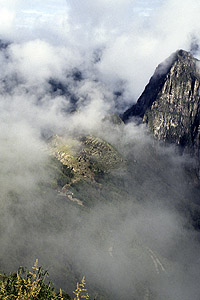
(Machu Picchu, Cusco, Peru)
The fourth and final day of the Inca Trail - Machu Picchu ! We were woken up this time at four in the morning. To the casual observer it may seem that the Inca Trail is just a series of increasingly early mornings with little return. This is mostly correct, the intention of getting up at four is to see the sun rise at Inti Puntu - the Gateway of the Sun. We were hustled like zombies into breakfast and then pushed out into the night. Amazingly everyone else was doing the same even the people who were travelling independently. We walked through the cloud forest for around an hour at first in the darkness and then in a half light barely sufficient to allow us to see the various steps and tree roots which threatened to trip us up. By the time we reached the gateway the sun was already up and hidden behind clouds and everyone was waiting on the Machu Picchu side. We sat own and one by one about a hundred more people joined us. Many of these had done a two day version of the Inca Trail which just takes you to Wiñay Wayna and Machu Picchu. What we found ourselves looking at was a huge white cloud of fog ad we looked at it for what seemed like hours on end.
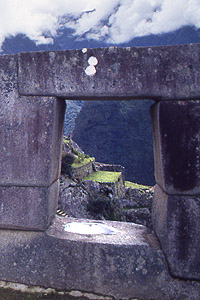
(Machu Picchu, Cusco, Peru)
Finally the sun rose above the mountain we were sitting on and shone into the Sacred Valley. The sun reflected off the Urabamba river and we could see its winding course thousands of metres below us. Very slowly the sun began to burn away the mist and gradually we could make out bits of the ruins. Machu Picchu is situated in what must one of the most amazing locations in the world. It occupies a saddle between two mountain peaks, Machu Picchu and Huanya Picchu. Below the Urabamba coils around the base of the mountains and all around are peaks and ridges of different sizes but all of them are sheer. Covering everything is dark green jungle. You can see why it took so long to find and it is amazing to think what it must have felt for Hiram Bingham like hacking the thing out of the jungle in 1911.
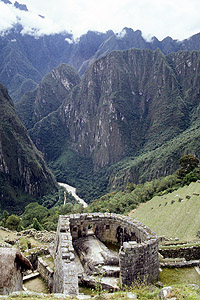
(Machu Picchu, Cusco, Peru)
After a brief chat about what we were going to do our guide lead us down the track towards the site. Along the way I desperately tried to get a picture of the ruins from high up. Every time the jungle allowed us a view one of the clouds would come in to cover either the buildings or the small peak. Instead I attempted to take pictures of other mountains in combination with nature. I found a small twig on which a spider had spun its web. The web was covered in dew and the dew lit up by the morning sun. In the background rose a snow-capped mountain. I framed the perfect shot and was about to take it when a hand reached in. I could not believe it some guy, totally ignoring me, had reached over to snap the twig so that his girlfriend could take a picture of Machu Picchu. Worse than this all she had to do was move a few metres either way and she would have got the same results. I ranted at the couple for a bit then moved on.
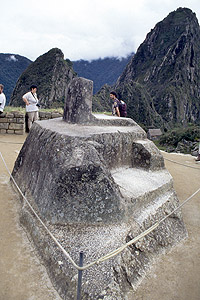
(Machu Picchu, Cusco, Peru)
At the site itself our guide gathered us together to tell us a few general things then showed us around the ruins. I must say that although the location and the history of the place is amazing do not expect to be stunned by the beauty of the buildings. A lot of the stonework is very ordinary and even the Temple of the Sun is surpassed by that at Pisac. In short if there were ever a competition to see what was the eighth wonder of the world, Machu Picchu would be up against stiff competition. On the entertainment side we tried to ask as many difficult questions as possible - Q: "Why did the Inca's not invent the wheel?", A: "because they had no use for it living in the mountains."; Q: "Given that the Inca's used the wedge and water technique for quarrying stone why are there no holes on any of the rocks?", A: "I'm not sure.". As usual it looked like a great deal of imagination had been mixed in with the facts to explain Machu Picchu away.
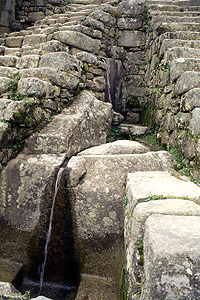
(Machu Picchu, Cusco, Peru)
Our guide had to stop guiding before he had quite completed the circuit of the ruins. He had to get our railway tickets. This was the biggest farce of the whole trip, rather than just saying how we would get back and letting people opt out the company had decided to present us with all the options. There are three different trains coming back from Machu Picchu and the earlier you go the quicker you get back and the more expensive it is. The difference between the two relatively fast trains and the slow one is that they cost three times as much and take half the time. To complicate matters you can get off the train at Ollantaytambo and change to a bus thereby cutting an hour off your journey. We decided to do this but the amount of effort our guide put into explaining the options and collating the answers was immense. We could have looked around the site for at least half an hour more. We were told that he would be coming on the cheap train and put us on to the correct bus so at least we did not have this to worry about (or so we thought).
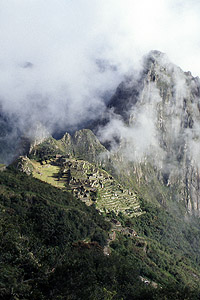
(Machu Picchu, Cusco, Peru)
We decided that rather than climb to the top of Huaynu Picchu or spend even more time at the site we would walk down to the Sacred Valley floor. This was in part to save some money but mainly because we had been captivated by the jungle and wanted to see more. Quite a lot of the other budget travellers in our group had made the same call and we set on mass down yet another stone staircase. It took us a while to reach the bottom and once there we still had a way to walk up the valley to get to Aguas Calientes where we would get the train from. The group reconvened at a restaurant of the guide's choosing and we chatted the afternoon away. As the different trains pulled in people disappeared in handfuls until there were only about ten of us left. Finally the "Cheap" train pulled in and tentatively we got on it.
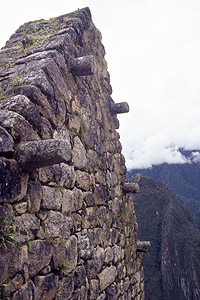
(Machu Picchu, Cusco, Peru)
It was quite a lot of fun on the cheap train. There were a ton of Israelis in our carriage who had all timed there Inca trail so they would be back at Cusco for the Passover feast on April 1st. Apparently it had all been arranged for months that masses of de-mobbed travelling Israelis would converge in Cusco on this date and attendance was rumoured to be around the thousand mark. Anyway it seemed like half of them were crammed in to our train and they certainly had been gripped by a festive mood. Whilst we were not chatting to the Israelis we were staring in awe out of the widow. The Urabamba, in full spate as it was the end of the rainy season, seemed unhappy about being squashed in between the steep mountains of the Sacred Valley. Practically every square centimetre churned, frothed, spat etc. and although we had not seen many rivers in their rainy season we speculated that the Urabamba must be one of the world's wildest rivers.
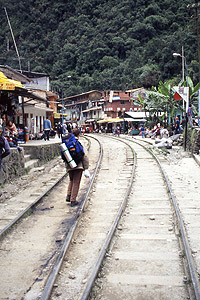
(Aguas Calientes, Cusco, Peru)
Strangely absent during all of this was our guide. In fact he did not even appear to be on the train. Despite this we got off at Ollantaytambo and followed the running masses and squeezed into a minibus. When we got to the town of Urabamba the connecting bus was not in the bus station so confusion reigned until our bus drove around town and found the onwards bus doing its rounds. The whole thing was not helped by a noisy Spaniard who was suggesting that for a few more Soles the bus could in fact take us to Cusco which went down about as well as if you had tried to get the number 19 to continue on to Brighton. Somehow we got seats on the other bus and tried not to doze off as it sped through the night.
Back in Cusco things were even more of a rush. We had a flight at seven the next morning and so we had to get all of our stuff together. Half of our stuff was in storage at the tour company and for some reason they were about to lock up for the night when we arrived. We got our stuff out and fought back the urge to complain about the trip back in favour of getting to bed early. we ran around to the hotel and were reunited with the remainder of our stuff and they found us a room. As a gruesome postscript to the whole day whilst I was having a wash down (a hot or even cold shower is a bit of a difficult thing to come by in Cusco in the evening) I found what looked like a small graze on my stomach. However after closer examination it seemed that what I thought was a bit of hanging off skin was in fact a tiny spider. It was not a tic so I decided to pull it off and although it took some effort it finally relinquished its grip. Heaven only knows what it was up to but it had only created a tiny puncture and it healed up very quickly. It still made both Anna and I feel a bit ill and there was talk of incinerating our clothes just in case another one was hiding somewhere.
Wednesday, 31 March 1999
Arequipa, Peru
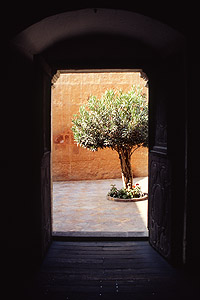
(Arequipa, Peru)
For some reason that I will never be clear about we had booked ourselves on the 0700 flight to Arequipa the next day. It is true that it gained us a day but waking up before five that morning this did not seem like sufficient excuse. We found a taxi which found the airport then we went through a system of different queues which adequately explained why we had to be two hours early for what was an internal flight. The flight was short but scenic as we flew over the wastelands of South Peru and got a bird's eye look at the huge volcanoes and mountains that surround Arequipa.
One would have thought that after all the running around and sleepless nights we would have gone to sleep as soon as we found a hotel. Not us. We dried our tent then had lunch and then walked around Arequipa. The two things that we wanted to do were go to the amazing Santa Catalina monastery and the Coalca Canyon. Anna also wanted to see some of the Easter Celebrations on the Friday so we penciled this in as our rest day.
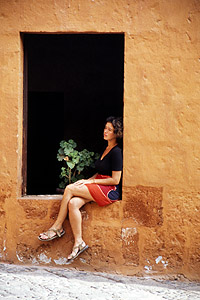
(Arequipa, Peru)
We finally got to the Santa Catalina Monastery at 1400. The monastery is laid out a bit like a closed city. The cloisters and cells are all attached by streets which all bear names and are open to the sky. Although only one quarter of the monastery is still used (and this quarter is closed to the public) a lot of the original furnishings and tools are still in place. The thing that is most impressive however is the use of colour. Throughout the monastery the walls of the streets are painted either in a strong blue or a very strong red. The contrast with the sky and the cool flagged floors is amazing. The contrast when you walk from a blue to a red area is more than amazing. To make matters worse there are strategically placed potted plants, orange trees and wall climbing shrubs everywhere. The whole thing looks like some sort of textbook on aesthetics or the "Use of Colour" chapter from a handbook of photography. I used nearly a whole roll of film wandering around the streets of the monastery. In addition to the beauty of the place it was also quite peaceful once you let the guided tour groups pass and we were able to sit and we were able to grab a few quiet moments of contemplation.
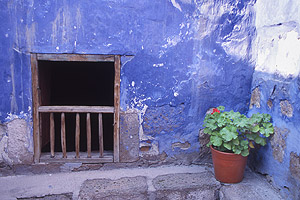
(Arequipa, Peru)
After the monastery we went to sort out our transport to the Colca Canyon the next day. The canyon if five hours by bus from Arequipa and our guide books had the buses and the tour groups leaving at four in the morning. When we finally got to the offices of the bus company we found that the buses now left at 0230. Somewhat dumbstruck we bought a couple of tickets and tried not to think too much about where our next hour of sleep would come from. On the way back from the bus station we got a bit of a surprise. Hans and Ester, rather than flying to Arequipa straight after the Inca Trail had stayed on in Cusco because Ester was sick. We met them in the street with a couple from their group who it appeared had got it together on the Trail. The guy was Australian and the girl was Peruvian. Instead of flying they had discovered (I guess with the aid of the girl) that there was a bus from Cusco which took them to the vicinity of the Colca Canyon. We met them later for dinner and they told us their hellish story of public transport around the Canyon area and how it was only by the goodwill of a tour group that they got back at all. They were going to look around Arequipa the next day and leave for Nazca the next evening. We finally stopped drinking and chatting around eleven and both Anna and I wondered if it was worth going to sleep.
Thursday, 1 April 1999
Arequipa, Peru
The alarm went off at 0200. At 0202 it was turned off. At 0204 we were both fast asleep again. Its not hard to explain why we never went to the Colca Canyon, after talking to Hans and Ester our will to go had slightly faltered and it needed a lot of will power to get up after less than three hours and get on a bus. My original reason to go was that it was described as like the Grand Canyon but deeper. Hans, having been to both, said that it most decidedly was not. From the descriptions it sounded like a dry version of Tiger Leaping Gorge and, if you trusted the Chinese, this was the deepest gorge in the world anyway. Anna's motivation for going was to see a Condor close up and despite the others having seen exactly this I do not think any bird however big would have been sufficient to get her out of bed at two. In addition to all this it involved ten hours in a bus and a lot of hassle. Hans and Ester later revealed that they thought us mad to even consider it. So we slept on.
We slept for hours and hours and hours. When we finally got up we realised we should not have bothered. Instead of having Easter Monday as a public holiday South Americans take the Thursday off. It was Thursday and nearly everything was shut. First we went to get our bus tickets out of Arequipa. We then wandered around poking our noses into the few open artesanias and took as long as possible to eat our lunch. We went to the market and then retired to the roof of the hotel to write our diaries. It was not that Arequipa did not live up to our expectations, the monastery was what we had come for and it was wonderful. It was just that we had not realised how far away all its other sites were and how dead it would be at Easter. Finally the bus came and it was time to go to Nazca.
Friday, 2 April 1999
Nazca, Ica, Peru
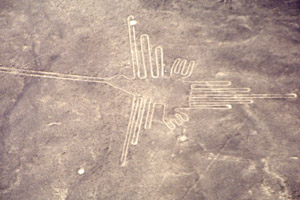
(Nazca, Ica, Peru)
We arrived in Nazca at 0430. Unsurprisingly it was as dead as Arequipa. Used to the early mornings and sleep deprivation we casually sauntered to the Plaza de Armas, ignoring the early bird touts, and sat down to wait for dawn. As we had expected would happen a bit before dawn Hans and Ester and the Australian guy turned up in the Plaza as well. The Peruvian girl's family had a beach house near Pisco and she had invited them there but had gone ahead (presumably having already visited Arequipa and Nazca) to tidy it up. The other three would see the Nazca Lines and then get a lunchtime bus up the coast. We all sat in the square and talked. Hans went to sleep under a tree and got covered in ants. A tout came up to us and explained how things worked in Nazca and how it made relatively little difference who we went with. Hans got up and quite rightly refused to believe him. We all traipsed off to the nearest agency recommended in the South American Handbook.
The guy at the agency wanted to take five dollars more off us and we decided it was worth it. Anna had already decided she was not going to fly and so we arranged a taxi to take her to the mirador, a small tower on the Pan-American highway from which you can see a couple of the figures. The agency guy took us to see a video on the lines. It turned out to be about the Incas and the pre-Incas and just about everything and only spent a couple of minutes discussing the lines. After forty minutes we got bored and walked out, outside we met Anna who had just got back from seeing the lines. After more waiting we were put in a truck and taken to the airport where we had to wait more. They put a video on to keep us amused, it was the same video. Normally I would have been getting quite cross at this point after all we had kicked the whole thing off around seven and it was now nine and we were still on the ground. However tiredness combined with the fact that there was nobody from our agency to talk to at the airport meant that I just had to wait. The tout we had talked to first thing in the morning was right, the agency had just dumped us in a queue for the next plane, pretty much as he said he would do.
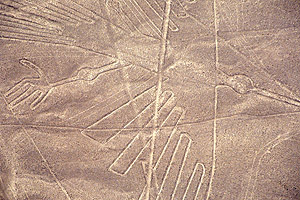
(Nazca, Ica, Peru)
Finally somebody from "Aero Condor" came to speak with us. Their bigger plane was being repaired and they had nothing bigger than a three seater so one of us had to go with another couple. I volunteered and was shown to a plane. The couple in the plane were Italian and did not give any evidence of speaking English. The plane was tiny. The smallest plane I had been in before was a Fokker and in comparison that was a jumbo jet. I got the co-pilot's seat and had all the complications of having a steering yoke in front of me. I also had all the dials in my face and was interested to find out that the plane had two fuel tanks and that rather distressingly the second was empty. The take-off was rather comical, with one hand the pilot pulled back on the yoke, with the other he pulled out something that looked a bit like the choke of a car. Rather casually we drifted up into the air and we cruised towards the area of the lines.
Anyone who knows anything about cameras would realise that at this point I should have been readying mine. The trouble was I have become so used to all the automatic settings and being able to take photographs quickly that I rarely think about it. The result was that it was not until we were over the first figure, of a whale, that it was impossible for my camera to focus on it with the aircraft bumping up and down. I was desperately wrestling with it when we got to the next figure, the astronaut. Well, this is what the pilot said but the trouble was all he did was point vaguely at the ground and repeat the word astronaut. It was around this time that I began to realise what was meant by "speaking English" when we were told that the plane pilots spoke English, Spanish and German. What it meant was that they knew the words for "Hummingbird", "Condor", "Monkey" etc. in all three languages and nothing else. Anyway I finally glimpsed the astronaut for two seconds just as we were speeding away by craning my neck and looking in the opposite direction to the one that the pilot indicated.
Between the astronaut and the next figure I got clued up to what I should do to get my camera working. I put it into manual focus and then attempted to crank the focus ring around to infinity. Sadly during my earlier attempts to focus it I had clearly smacked the lens against something in the cramped cockpit because now the focus ring would not turn. So I forced it and it made a few snapping noises and eventually I got it in focus. By this time we had got to the monkey and dog and the pilot was enthusiastically gesturing towards the ground and steering with the other. I completely failed to see either of them, the problem was that the lines were rather thinner than I had expected and I had not borrowed Anna's sunglasses (my own having been stolen in Santiago). I briefly experimented with using my camera to get a closer look at the ground but the field of vision was simply too narrow. The plane was moving around so much and the pilot's gesturing so vague that I had a huge area to search. Again just at the last minute I managed to spot the monkey's spiral tail but I did not have enough time to follow it back and find the body.
Out of all of the figures I probably managed to see half of them. The most impressive was the hummingbird as this was scratched out in the darker earth of a plateau and was very clear. The problem I realised was not just my eyes however. The whole trip was like a game of bingo, you just sat in the airplane and ticked off the figures as you saw them. Nothing was explained, none of the theories about the lines were revealed. Only the animal shapes were pointed out, no attention was given to the straight lines which a lot of people think are the most important. Okay it was cheap and I guess we could have paid a little more money for a guide. However I doubt it since the whole of Nazca was like some sort of conveyor belt designed to get you into a plane and out as quickly as possible. Some people did pay more than us and got in exactly the same planes.
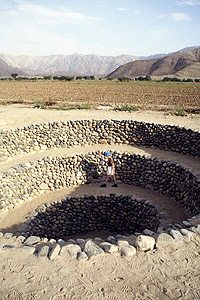
(Nazca, Ica, Peru)
To make my mood worse when I got back down none of the others were there and after a wait someone finally came and told me that they were still in the air, which is what I had already assumed. It turned out that they took off just after I had landed so I had to wait nearly forty minutes before they turned up. The waiting, however, was not over. No-one from the agency was present to take us back and it was well over a quarter of an hour before someone appeared in a battered Chevy and motioned for us to get in. At first we refused not knowing whether the Chevy had been sent or the guy beckoning was just an opportunistic taxi driver. After all the car looked like it was from a different planet in comparison to the brand new people transporter we had been taken to the airport in. Finally, exhausted by the situation, we just got in - which turned out to be the right thing to do.
After all these months you would think that having received such a poor service I would have gone straight into the travel agents and seized the guy by the throat. Fortunately for him I could not be bothered. I had a headache from staring at the ground and so went straight back to the hotel and laid down. Eventually Hans and Ester came round and we all went for lunch. After lunch we said goodbye to them for the final time. They were going to the Peruvian girl's beach house in Chincha and we were going to the wild's of Paracas National Park. Once their bus had left we went back to the hotel and slept some more.
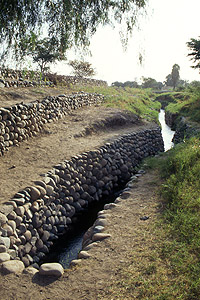
(Nazca, Ica, Peru)
When we finally woke up it was a bit too late to do the three hour walking circuit we had planned. We salvaged the situation by getting a taxi to the first stop on the route, the Nazca irrigation canals. The Nazca Culture knew a thing or two about irrigation and bought water down from the Andes to irrigate the fields around Nazca. The underground aqueducts they built are not only still in existence they are still in operation. In one of the villages near Nazca it is possible to visit the air vents of these aqueducts. Huge stone lined spiral holes which you can walk down following its slope to get to the water channel. We popped inside a few of them, looked at the cool clear water flowing in the channel, looked at the fish and generally marvelled at the design. I am not quite sure why we marvelled since on our travels we had seen many aqueducts and most of them were twice as old as this four or five hundred year old specimen. However it was a pretty unique design and we had never seen quite so much work put into a water channel. After this we continued walking following some pretty vague instructions towards the middle of nowhere. Along the road some children tried to throw stones at us and succeeded in shouting "Gringoes" at us. We felt a bit sorry for them, very few places on our trip had we encountered children who had approached us with the innocence you would expect from a child. We swore back at them in Spanish and English and walked on.
After a while we found Pardones, a pre-Inca market town. There was very little to see but it provided a good spot from which to watch the sun setting on Nazca. Pardones was not too far from town so we walked back, on the way stop at a few artist's workshops in an attempt to find something worth buying. After failing miserably we went to dinner at one of Nazca's surprisingly expensive restaurants and then went to bed.
Saturday, 3 April 1999
Paracas, Ica, Peru
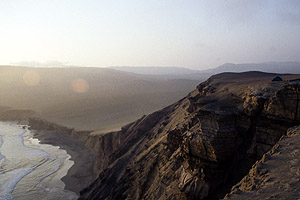
(Paracas, Ica, Peru)
Not wanting to waste a minute more of our rapidly coming to an end holiday we caught the first bus out of Nazca at 0715. It was not going all the way to Pisco so we were forced to change to an even more ropey bus at Ica. Whilst waiting for it to leave we were sold ice-cream by a guy standing on top of his wheeled ice-cream cooler being pushed backwards and forwards along the windows of the bus by his partner. When we arrived in Pisco we quickly found a hotel and went through our rehearsed routine. We asked to book a room for the night we would come back from Paracas quickly following it up by asking if they had somewhere to put our bags until then. They went for it and relieved of most of the contents of our rucksacks, and the bag stuffed with presents, we went for lunch.
How to get to Paracas Peninsula was not something that was too well explained in the Rough Guide. In the book the bus journey was only described up to the entrance of the park. Seeing as there was a major port on one side of the park it seemed likely that there was transport within it but it would be difficult finding. This difficulty was complicated that what the locals called Paracas was a small beach resort a couple of kilometres from the park gates called El Balinaro in our books. We found this out on the way there. Using any of the other place names in our books confused the matter further and in the end the bus drivers decided to drop us in the beach resort, also called Chago, which was where they turned around to go back to Pisco. Asking in shop lead to more confusion and when some of the hundreds of micro drivers finally recognised the phrase "Parque National" figures of twenty-five soles and up were mentioned. We decided that we would be walking the remaining seven kilometres which is half what we had expected all along. We walked for about half an hour before we were rescued from the heat by a micro going exactly in the direction we wanted.
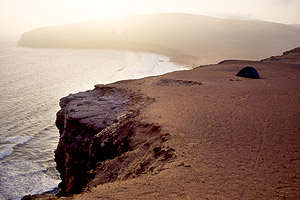
(Paracas, Ica, Peru)
Lagunillas was not the sleepy little fishing port we had expected. It was the Easter weekend and with free camping (on the two long beaches either side of the spit of land joining Lagunillas to the coast) the place was packed out. We decided to walk as far away as possible and set off along the cliff tops. Slowly we got acquainted with the environment. Paracas is a desert, nothing grows in it but a surprising amount of creatures live in it. We were walking on sand dunes on the top of sandstone cliffs. The only thing we could see apart from sand was the sea or the occasional fish eagle launching itself from the cliff or wheeling overhead. We passed one beach which was lined with cars - clearly the more remote areas of the park were not that remote if you had wheels - so we had to carry on. We did not stop until we got to a cliff overlooking the second beach marked on our map. This beach was again lined with cars and we realised that the only chance for a bit of peace and quiet was to stay where we were, well away from the roads on a cliff top only visited by walkers and the odd rogue 4x4.
The sun had begun to set by the time we had finished getting the tent up. I took a photograph of our tiny tent looking very independent on top of our sandstone cliff backed by endless desert. We talked until the sun disappeared below the headland on the other side of the bay then had our dinner of cheese and biscuits before going to sleep. I was amazed that we had got so much done in a day, at the start of our camping adventures in South America it used to take us a day to prepare for our trips, buying food, repacking etc. Now we had got the whole process down to a couple of hours which had meant that we could wake up in Nazca, lunch in Pisco and go to sleep in the middle of the desert. Sadly we had perfected the art just a few days before we were due to leave - but I guess that's always the way!
Sunday, 4 April 1999
Paracas, Ica, Peru
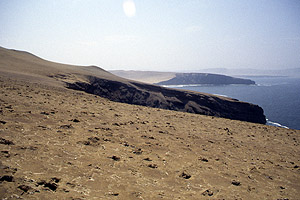
(Paracas, Ica, Peru)
Waking up in the desert with the freezing cold morning air, the sun just beginning to poke up above the horizon and the waves crashing into the cliffs below us was a pretty unforgettable experience. We laid outside the tent and watched as the sun rose and slowly warmed us up. Finally we packed up and got on the move. We were not quite sure where we were going, or indeed where we were, but we felt sure that after bit of walking all would become clear. We went down quite a steep hill and found ourselves on top of the low cliffs which skirted the beach below our camping spot. Here what looked like fish eagles, with a huge wingspan, black feathers and red collars, loitered around in groups. As we approached they would leap out and soar up on the breeze blowing up the cliffs.
It was on the top of these cliffs where we had seen a row of cars the day before. Because of this we decided that today we would try and aim for somewhere where we would find nobody else. We continued past the long beach and climbed up towards what was labelled as "mirador los lobos" or the sea lion lookout. We totally failed to find the lookout point and eventually came to a plain of salt structures. It seemed quite improbable but there was evidence here that it had rained at some point in the past (probably as a result of El Ninõ) and the rain had washed the thin soil away and exposed the salt rock below as a series of white cracks and melted crystalline structures. Here we saw a thin white lizard that darted off at an incredible speed running in that way that lizards use to avoid burning their feet on the blistering sand. Apart from the tracks of the nocturnal desert fox these lizards were the only land creatures we saw the whole of our time on Paracas.
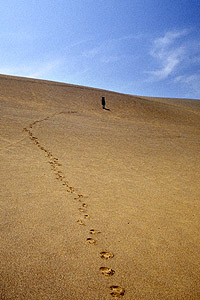
(Paracas, Ica, Peru)
Rounding a small hill we found ourselves high above another huge bay. It was pretty much like the bay we had just left except for the fact that there was no beach. We sat down and pondered whether it was really worth going all the way down to the bay. The scenery although stunningly beautiful was identical to the bay before and we would have even further to walk back the next morning. So we decided to turn back and camp in exactly the same spot as the night before - there was no way you could describe it as crowded and it had a terrific view. We did, however decide to walk back via a different route. Through the dunes instead of along the coast.
One thing I slightly regret about our trip is that we did not spend more time in the desert. The air is beautifully clear and the scenery is so dramatic. But the thing that never failed to amaze us was our own footprints. Because the surfaces are so flat shadows are very clear cut and you can usually look behind you and see the line of your own footprints stretching back for quite a way. It is a very clear record of where you have been and the unmarked wilderness which stretches out in front of you taunts you with how far you have yet to go. Hiking in other places you hardly ever get such a sense of the journey. In the desert your footprints are so well defined that the trip takes on a physical dimension.
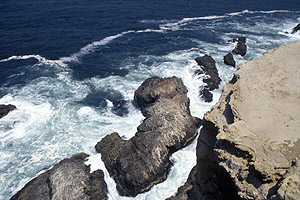
(Paracas, Ica, Peru)
The dark side of this is of course that walking through the desert you disturb a delicate balance. It turned out that even the barren soil of Paracas retained some moisture. The wind had blown away the light sand and left a thin layer of tiny red stones which formed a protective shield against more erosion. This layer also kept in some of the moisture floating around in the night air. Just by walking through the desert in Paracas you destroyed this layer, some more of the soil would be erode away and with it the precious moisture that it kept in. We were however nowhere near being the worst offenders. Judging by the hundreds of tyre tracks crisscrossing the peninsula was the top destination for wealthy Lima citizens wanting to test out the off-road capabilities of their 4x4's.
We crossed the dunes, ran into a Spanish couple who told us where the sea lions really were, saw the sea lions and then went to the beach. There was not much to the beach. It was just a black sand stretch with an alarming amount of debris on it and a sea which had a strange yellowish tint to it which we suspected had something to do with the oil from the hundreds of fish canneries just up the coast. Nevertheless we sunbathed on it for a while before returning to set up camp. Once the tent was up we had dinner watching the sun set over the next headland and then played cards and stared at the stars.
Monday, 5 April 1999
Pisco, Ica, Peru
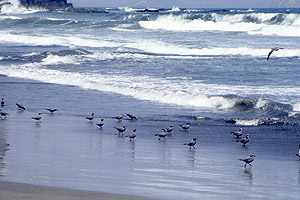
(Pisco, Ica, Peru)
The climate of Paracas is also quite alarming in its clarity. In the morning the air is completely still and very cold. As the day progresses the sun warms the sand up to an amazing temperature in the centre of the peninsula pushing the air up and sucking air in from the cooler sea. Thus the wind builds up slowly through the day and just before sunset it reaches its peak then drops off as the land cools off. This weather system was so simple you could almost set your watch by it. Thus waking up at exactly the same time and in exactly the same place as the day before we were greeted by the same cool crisp air and the sight of the sun rising over the dunes.
We had no real idea how we were going to get back to Pisco but we packed up and started walking knowing that somehow we would. We took a short cut back to Lagunillas and were there pretty early on in the day. The change in the place now that the holiday crowds had gone was dramatic. Where there had been crowds of tents and cars now there was only a litter strewn beach. One of our bottles of water had tipped over in the night and its top being loose we had lost most of it. So we walked into the small dock area and tried to find a cheapish bottle of coke. The owners of the restaurants, their one lot of custom for the year having disappeared were a bit desperate and blew any chance of selling us a coke by being stupid about the price. In the end we found a small stall by the dockside who sold us a couple of bottles for next to nothing. We then asked abut buses which was, as usual, a bit of a mistake. The usual preconceptions about foreigners came into play and they started inventing prices at which we could charter a bus to take us back. In the end we found someone who was a bit more sympathetic who told us what we knew all along that there would be nothing for hours. Buses only came to Lagunillas to drop fishermen off in the morning and pick them up again in the night. The only other option we had was to hitch a lift from one of the fish trucks that left from time to time but the smell they gave off meant this was not an option. It was clear that the only means we had of getting to Pisco before the millennium was over was Shanks' Pony.
It was hard work but seven kilometres of trudging through bleak desert landscape on an iron hard road later we reached the entrance gates of the park. We then started off towards the nearby beach resort but Anna fortunately intercepted a passing micro and we hopped in that and rattled our way back into Pisco . Once back everything went like clockwork, the hotel where we had left or stuff had superb showers and it took very little effort to wash three days of travelling dust off. We had a huge lunch and then wandered around town for the rest of the day.
Of course by this point we were a little shell shocked. For nine months we had been wandering around wherever we liked and now we were just a few days from being back in England. Our route back was cast in stone and we had little left to do. Always when travelling we had the next big treat to look forwards to - Sichuan, Torres del Paine, the Inca Trail, Paracas - the list had been endless. Now there was nothing but Lima which is looked upon as a necessary evil rather than a treat by most travellers. We tried to make the best of Pisco that night but I think we had already hung up our travelling boots back in the desert.
Tuesday, 6 April 1999
Lima, Peru
We took an early bus from Pisco to arrive in Lima before midday. It was pretty uneventful, the string of beaches below Lima were nice but the string of restaurants which lined each one ensured that we did not resent our time in Paracas. The suburbs of Lima were as unappealing as the suburbs of most capitals and the size of the place made us feel glad that we had already booked our hotel. We took a taxi and we were checked into the very pleasant Patio hotel in Miraflores in time for lunch.
To explain a bit further Lima is a vast sprawl of ten million divided into a number of different neighbourhoods connected by huge exhaust choked arteries. Miraflores is one of the trendiest, most upmarket and safest neighbourhoods of Lima. This safety however has been bought at some cost. We had grown slowly used to increasing levels of security as we went northwards through South America but it was at an extreme in Lima. For example every bank was, as usual, guarded by armed guards but instead of pistols they nervously fingered sub-machine guns. One of the most amusing sights was the navy headquarters, a fairly old building, outside of which stood two sailors in Persil white bell bottomed uniforms and huge assault rifles. It was not only the banks, virtually every shop had some hired gun lurking outside its doors. Many places were guarded twenty-four hours a day. Later that night we had the rather gut wrenching experience of rounding a corner half drunk and almost running into a guard in bullet proof armour holding a nine millimetre. Top all of this with other subtleties such as the straps on all the chairs in MacDonalds which you could clip your bag to and you start to get the impression that things were pretty dangerous in Lima not so long ago.
We spent most of the day trying to get our last few errands finished off. As usual we had a great time trying to get rid of our second hand books. We found a small book market where a couple of the vendors each had a box of moldy romance novels. We showed them our books and they huffed and puffed and told us that they were not interested in them because they were not classics. Quite perversely classics had been the only thing that you could easily get hold of in Asia and so were ten a penny on the Khao San Road but we had long established that second hand book dealers were a law unto themselves. In the end we forced our three modern thrillers on them in return for a copy of a Len Deighton we did not really want. I was tempted by the only other work of any magnitude they had, a dusty copy of "Fanny Hill", but in the end thought better of it.
That night we went to see "Shakespere in Love". We thought it was great but of course we did not have to suffer all of the hype that, we found out later, had put a lot of people off seeing it back home. After this we had a not so pleasant experience trying to find some dinner. The only places with any life were the twenty or so pizzeria's on Miraflores' "Italian Avenue" but it took us three goes at running the gantlet of waiters before we found anywhere that we could stand. We had the shock of our lives when we looked at the prices - which would have been offensive even in London - but for some reason everywhere had two for one deals which reduced the prices to only mildly shocking. To make matters worse our waiter completely lost interest in us after we had ordered and it took a lot of effort to get him back in off the street to give us our bill. We soon found out why, the service was automatically added in and a whopping great luxury tax added on top of that. I thought about not paying the service but after nine months of upholding principles we could not be bothered having an argument on our last night.
Wednesday, 7 April 1999
Lima, Peru
Our last day. You could accuse us of letting the whole thing go out with a whimper rather than a bang but as I said before we had hung up our rucksacks in Paracas. We slept in for a long time. Rather bizarrely for such a nice hotel reception rang us up to ask when we would be leaving (they were very short of rooms) and we told them when we were ready. Then we went shopping yet again, picking up a few bits and bobs for people we had forgotten all about. And that was pretty much it... around eight we caught a taxi along Lima's very pleasant coast road, checked in, were forced to pay an exorbitant twenty-five dollar airport taxi, spent half an hour filling in a questionnaire with someone from the Peruvian tourist board and then got on the plane back to Europe.
Thursday, 8 April 1999
Amsterdam, North Holland, Netherlands
I seem to remember nine months ago debating where this diary should begin. Having decided that Amsterdam was not the real starting point it seems a bit hypocritical to even mention that we stopped in Amsterdam for a night on the way back, but I will jot down a few words anyway.
One thing that scared me about going away for such a long time was coming back and realising how little things had changed in nine months. Fortunately, for a day anyway, I was spared this My friend Dean, whose flat we had stayed in on the way out, had met a girl called Solveig and they were now sharing a flat over in the old East India Docks area of Amsterdam. Thus the end of new things was spared for a day. We went out for a curry together and slowly but surely drifted into European mode. The prices were astronomical and the landscape too flat but we were home at last.





